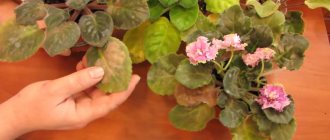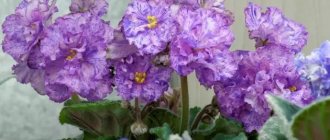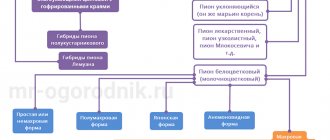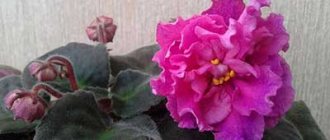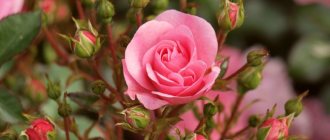Violet variety PT Angelica has large, double or semi-double flowers of a soft pink color with a spotted pattern.
It blooms profusely and for a long time, but not often. The flower rosette is large, the leaves are simple. The plant is unpretentious to growing conditions. The variety is popular due to its ease of care and decorative appearance. Dear readers! For you, we have created communities on social networks in which useful articles and interesting ideas are published several times a day! Subscribe and receive useful content in a convenient format!
Violet PT-Angelica (T. Pugacheva)
Funny violet PT-Angelica.
Genus, family
The PT-Angelica variety belongs to the botanical species Uzambara violet.
Systematic position of the species:
- Family Gesneriaceae – Gesneriaceae;
- Genus Saintpaulia hybrid – Hybrid Saintpaulia;
- Species African violet saintpaulia hybrid.
History of the variety
The PT-Angelika variety was bred by the wonderful Kursk breeder Tatyana Pugacheva . Tatyana varieties are characterized by:
- Long cap flowering;
- Large corollas of violets;
- Dense, stable peduncles and petioles.
Photo and description of the variety
Uzambara violet variety Angelica blooms with large double flowers of deep pink color . Along the corrugated edge of the petals there is a two-color crimson-white border.
The petals have rare blue spots . The variety forms a large spreading rosette. Leaf blades:
- Bright green;
- Round-ovoid.
The edge of the leaf is crenate. The variety blooms for 3-4 weeks .
The variety has pink flowers.
Variegation, imprints
color :
- Uniform;
- Dark green.
Printings are not typical for the variety.
Sports
Angelica's sport is different:
- Lighter color of petals;
- And the absence of blue specks.
Violet has a lighter sport.
Detailed examination of the life stages of a seedling
The seedling rhythmically almost completely corresponds in terms of the passage of its life processes to the flow of the same phases in most species of the genus. This means it’s easier for flower growers to create schedules for caring for this tropical beauty – all you need to do is:
- Check the standard;
- And take into account the nuances of the individual development of the seedling.
Specifics of room development
Seedling specimens can be called an ideal object for novice Saintpaulia collectors, since the violet has many positive characteristics, although there are also minor nuances of a negative nature.
The favorable qualities of Saintpaulia, which positively influence the choice by gardeners of this particular variety for further cultivation in an indoor collection, include:
- Harmoniously formed leaf rosettes, independently collected by the violet;
- A huge volume of blooming flowers, sometimes covering the entire leaf mass;
- Long-term preservation of the fresh appearance of the flowering cap, which becomes possible due to the covering of faded corollas with new flowers;
- Good preservation of color range from flowering to flowering;
- A large number of children when propagated by leaf;
- Lush flowering anywhere in the room - both on the window and on the shelves;
- Lack of obvious response to leaf pruning for propagation and to slight temperature fluctuations.
Like all Saintpaulias, the seedling somewhat overshadows the positive opinion about itself with some negative nuances:
- Violet prefers a freer arrangement in the space of the collection - in this case it forms an ideal bush configuration;
- The seedling gradually increases the power of its flowering, the cap is possible after the second wave of flowering;
- The corollas do not open at once - this happens in order, but does not affect the decorative appearance due to the large number of buds;
- The width of the white frill on the petals can change with temperature nuances;
- The wavy edges of the leaves slightly increase the compactness of the rosette in young seedlings and can provoke the leaves to hug the flowerpot - in adult specimens these problems disappear.
Formation of an adult specimen
The process of a seedling passing through the teenage phase depends on the method of obtaining young specimens :
- If you take a baby from a leaf cutting, it will take about a year before the first flowering and entry into the adult stage of development;
- If you take the stepson from the mother violet, the time will be reduced somewhat.
Peculiarity of reproduction
For violet growers, only two vegetative methods are available from the general arsenal of propagation modes:
- Numerous children germinating on leaf cuttings is a priority method for this seedling;
- Stepchildren formed by the mother violet and separated from it.
It is not permissible to propagate a seedling using seeds, since there is a high probability of losing all its distinctive features.
Flower response to temperature
The seedling is somewhat dependent on the temperature gradient :
- In cool weather, the flowers are lighter with a wide white border;
- And when it’s hot, the brightness of the color increases and the thickness of the edging decreases.
Pedicel structure
The seedling is characterized by the formation from the moment of the first flowering of strong, plump and stocky peduncles , the strong structure of which quite easily supports the voluminous caps of the violet in an upright position.
Flowering type
The seedling increases the volume of its caps of large corollas after the second flowering. Lushness is achieved due to continuous flowering and alternate opening of buds.
The violet blooms very luxuriantly.
Lifespan of a flower
The flowering of the seedling continues almost without rest , and each flower remains healthy and decorative for up to five weeks.
Violets, domestic varieties
Violets, domestic varieties
–
PT-Angelika
| Do you remember “Marquise of Angels”? - Luxurious, beautiful and strong... so is this violet. | Flower from another rosette. Both were grown from the same leaf. | Second bloom |
| Complete plant. I think that this is still far from the most abundant flowering. The socket is young. | Miracle, how good! | Winter portrait |
| Winter bloom |
Page 1]
Photo albums
- Violets, foreign varieties
- Violets, domestic varieties
- Varieties of Korshunova
- Lebetskaya varieties
- Repkina varieties
- Mini, semi-mini
- Trailer violets
- Chimeras
- Episces
- In the interior, or how we grow
- Daughter's orchids
- Winners and prize-winners of photo exhibitions
© 2011-2016, “Violets in Altai”
Personal website of Tamara Bobina,
Site Map
e-mail:
Website development "Active Design"
Violet Ness Orange pekoe
Fans of variegated and unusual varieties will definitely pay attention to the Ness Orange pekoe violet, which generously bestows its owners with double or semi-double flowers of a luxurious salmon hue. Such corollas look especially impressive against the background of dark green leaf blades, edged with all tones of white and pink. The underside of the leaves has a pronounced red tint.
Description of the plant
The leaves of this variety of violets have the same dark green color as other varieties of violets. The plant stands out especially due to its unusual flowering. Violet flowers most often have a beautiful soft pink or pinkish-purple color.
“Angelica” blooms with fairly large flowers, which can sometimes reach almost 10 centimeters in diameter. Compared to other varieties of violets, “Angelica” blooms for about a month, which is quite a long time.
The variety was bred artificially, thanks to the Russian breeder Tatyana Pugacheva.
Contents in room culture
Experts recognize the seedling as a non-capricious variety of violets with an easy character - it simply gets used to the microclimate of a certain room, develops quickly and blooms very much almost without rest, thus responding to simple agricultural techniques in its maintenance, subject to careful implementation of all regimes :
- It is correct to place the seedling on a western or eastern window; specimens on northern windows require additional lamps with a diffuse spectrum; on southern windows, artificial shade is required;
- Worth watering in small volumes, when the effect of light drying appears at the upper tier of the substrate;
To grow well, violets require proper care. - Additional mineral fertilizers should be used based on the decorative appearance of the violet;
- It is better to create lighting that is mostly natural, long-lasting and diffused;
- Suitable temperature is within the range of +20 + 24°C, excluding sudden fluctuations in indicators;
- Seedlings should be planted using nutritious, permeable soil with good aeration and a thick layer of drainage;
- When transplanting, use transshipment more often, except in special cases;
- Humidity indicators should be corrected by any possible means; only spraying the violet is not permissible.
Horned violet (Viola cornuta)
Her friend, the horned violet, is no less famous. It gets its name from the spur at the back of the flower that resembles a small horn. This perennial, depending on the variety, has a height of 10 to 20 cm. With a fairly small flower size (from 1 to 3 cm), violet is perfect for creating a flower mat. And my favorite lavender-blue variety, Blue , is a prime example of this. Moreover, they sold it to me without roots, just a twisted spiral sprinkled with earth. In a couple of years, this “something” turned into a mat of wondrous blue beauty, blooming from the beginning of May until the snow. Arriving to close the roses in November, I was surprised to see this blue miracle blooming after a severe frost, the sun had barely warmed up. The violet also bloomed during the dry spell of 2010, when there was no water for irrigation. At the same time we see a large number of flowers on the bush. And this allows you to have a fairly saturated color spot in a small area.
|
|
In addition to the Bud Blue variety, there are many varieties on sale today with a variety of colors: in a yellowish range - Etain , Splendens , Rebecca . I call Rebecca (white-yellowish with a bright blue border) zhovto-blakitna in the Ukrainian manner. Its color is bright, it blooms intermittently, from spring to frost, it creeps slightly, but is not aggressive, the bushes fall apart a little over time. There is also soft blue with a yellowish center Icy but Spicy, light pink Victoria's Blush , purple Martin , dark purple, almost black Molly Sanderson and white perfection White Perfection.
In cultivation, horned and hybrid violets have their own characteristics. Horned violet grows better in a sunny place; shading weakens flowering and makes the plants looser. Hybrid violet prefers moderate temperatures, so it is recommended to use it in partial shade, or in combination with taller plants that protect from overheating.
Diseases and pests
If the violet is properly cared for, it rarely suffers from pests.
Diseases in these plants may be as follows.
- Fusarium. This is rotting of the root system, degradation and softening of the leaves. It is not possible to cure violet.
- Gray rot. Appears when the soil contains excess moisture. You should treat the flower with “Fundazol”, stop watering, sprinkle with rubbed charcoal and transplant into another container.
- Powdery mildew. Quite a dangerous disease. A fine white rash similar to talcum powder appears on the leaves. The violet should be treated with Topaz; there are also other fungicides.
- Mite. A pest that multiplies quickly and can spoil several violets at once. When it occurs, the leaves become covered with a yellowish coating and fall off. Such parasites appear as a result of a dry room and too high a temperature. You should make a solution of laundry soap and wipe the leaves and stems with it.
- Thrips. This is another dangerous pest that can attack the plant if there is not enough humidity in the room. In this case, Saintpaulia should be sprayed with insecticides “Aktellik”, “Inta-Vir”, “Fitoverm”, “Aktara”.
- Nematode. If you start a violet infected with a nematode, the plant will have to be eliminated (along with the soil and container). But if the violet has just “picked up” such an infection, then it should be treated with Fitoverm.
- Aphid. Treatment should begin as soon as the first signs of infection become noticeable. Signs of aphids: leaves turn yellow, gray, brown. It is treated with the same drugs as in case of tick infection.
As preventive measures, the plant should be exposed to diffuse lighting (at least 12 hours daily), fed with various chemical compounds, and watered in a timely manner. In addition, be responsible for the propagation of violets and the composition of the soil. If there are any signs of illness, immediately isolate the plant by moving it to another room.
For information on the soil and volume of dishes for Saintpaulia, see the video below.
Caring for a plant at home
Violets are well adapted to being kept in homes , caring for them is simple, the most important thing is to strictly follow all the rules and recommendations.
Conditions of detention
Optimal maintenance conditions are the key to health and abundant, long-lasting flowering.
Proper watering and fertilizing
Water violets only when the top layer of soil has dried . Watering frequency is determined:
- The nature of the substrate;
- Age of the plant;
- Its size;
- Air humidity;
- And even the material from which the pot is made.
Water for irrigation is left to settle for 24 hours , during which time it:
- Will become room temperature;
- Will be freed from residual chlorine.
ADVICE! It is very convenient to water Saintpaulias from a large syringe, directing the stream to the edge of the soil near the wall of the pot. By watering in this way, we protect the leaves and growing point from moisture.
It is convenient to combine watering with fertilizing with liquid complex fertilizers . Such compositions contain nutrients in chelated form and are easily absorbed by plants.
At different periods of life, Saintpaulias need different combinations of nutrients:
Saintpaulias need to be fed periodically.
- Nitrogen is most needed when the violet is actively growing leaves;
- The plant needs phosphorus and potassium : Laying a large number of buds;
- And long flowering.
ATTENTION! It is often easier and more effective to replant a violet than to fertilize it.
Lighting and temperature
Uzambara violet variety PT-Angelica feels good on window sills oriented east or west, where the sunlight is bright enough, but does not burn.
Saintpaulias need 10 hours of daylight:
- If there is not enough sun, you can use a phytolamp;
- If there is excess, shade the plants.
Temperature range acceptable for Saintpaulia: from +18 to +240C . In heat above 300C and cold below +130C, the violet will die.
In summer, when the air temperature is elevated, the white border on the petals is absent , and in winter, when it is cool, it is especially pronounced.
Air humidity
When growing the variety, you need to maintain humidity at 60-70% . In winter, a household humidifier will help create this level of moisture.
What kind of soil does he prefer?
Violets require soil with the following characteristics :
- Loose;
- Breathable;
- Nutritious;
- With a slightly acidic reaction;
- Not prone to compaction.
Soil for violets can be bought at a flower shop.
There are two approaches to composing soil for violets:
- With a carefully balanced complex composition, violets can be grown on such a substrate without additional fertilizer. Most often a mixture consists of equal parts:
- Sod land;
- Vermiculite;
- Sphagnum;
- Additionally, add 1/10 of the total volume of special soil for violets.
- A simple substrate made from a mixture of perlite and sphagnum. Planting in such a substrate requires regular application of fertilizers.
Pruning and hygiene
The rosette of an adult violet is formed by removing the lower leaves, trying to ensure that the leaf blades of the upper 3-4 tiers are arranged like tiles on a roof, minimally overlapping each other.
Angelica produces many children ; they must be removed from the mother plant, even if the variety is not planned to be propagated. Children spoil the appearance of the violet; their growth wastes the flower's strength, which is necessary for good flowering.
House dust settling on the fluffy leaves of violets:
- Spoils the appearance of plants;
- And it harms their well-being.
Regular showers will benefit the flowers and make the greenery brighter. Dust from the leaves is washed off with a thin stream of water at room temperature. Each leaf is washed separately. The soil in the pot can be protected with a bag.
IMPORTANT! The violet should be left in the dark to dry. If you expose a wet plant to direct sunlight, burns cannot be avoided.
Reproduction methods
Most often, violets are propagated by leaves.
Uzambara violets reproduce well vegetatively:
- Leaf cuttings;
- Peduncles;
- Children.
The Angelica variety produces a lot of babies. Seed propagation is used by breeders.
Transplant rules, rejuvenation
An adult violet is replanted once every two years , otherwise the plant will bloom poorly and lose its decorative effect.
Often, instead of a transplant, a rejuvenation technique is used . In this case, use a sharp knife to cut off the stem under the lower leaves, leaving a stump 5 mm long. The stump is immersed in water, and after the roots appear, it is planted in a pot. You can immediately plant it in fresh soil, covering it with film or a jar.
Growing conditions
Violets are delicate, light-loving plants. They grow best on a windowsill with bright, diffused light. It is important to avoid direct sunlight. This leads to burns on the leaves. It is best to place plants on the north or northeast side. This will ensure abundant flowering in summer.
Attention! If the plants are located on the south, southwest or east side, it is recommended to shade the pots.
It is important to protect plants from drafts. Due to the flow of cold air, the leaves lose their decorative properties and beige spots appear on them.
Priming
The soil mixture for Saintpaulias is light and loose. It is designed to retain moisture. If you prepare it yourself, add vermiculite and perlite for drainage. Or purchase a ready-made mixture for violets. Plants prefer slightly acidic soil.
Important! The soil should be constantly moist and “fluffy”.
Pot
The plant grows well in plastic pots. It is recommended to increase the container size during transplants. The optimal diameter of the pot is from 9 to 10 centimeters.
Carefully! It is not recommended to use pots with a diameter of more than 10 centimeters.
Lighting
Like all varieties of violets with dark green leaves, Angelica requires increased lighting.
Daylight hours should last 12 hours.
When there is insufficient lighting, the cuttings and peduncles stretch.
Excessive sunlight causes leaf edges to droop.
Temperature
The optimal temperature for PT Angelica is 19 – 22 C. Plants do not like heat, this leads to a change in the color of flowers. It is undesirable for the night temperature to drop below 19 C.
Humidity
Water the plants generously with warm water. When humidity is low, the leaves turn yellow and die. At the same time, moisture should not be allowed to stagnate in the soil. To ensure high air humidity, containers with water are placed nearby.
Articles about other varieties: violet “Goddess of Beauty”, violet “Sea Wolf”, violet “Southern Night”, violet “Dance of the Galaxies”, violet “Black Pearl”, violet “LE-Chateau Brion”, violet “LE-Isadora”, violet “Duchess”, violet “Winter Smiles” and others.
Care
Containers with young plants are covered with glass. The greenhouse is regularly ventilated and condensation is removed. It is removed after 2–3 true leaves appear.
Watering
Water 1 – 2 times a week. Bottom watering is suitable for violets. The pots are placed in trays, which are filled 1/3 with water. Water should not be allowed to stagnate.
Transfer
A transplant is needed once every 3 years. It is done using the “transshipment” method without damaging the roots. Charcoal drainage is poured into the bottom of the pot.
Fertilizer and feeding
Fertilize violets during the flowering period. Young plants need complex mineral nutrition. Nitrogen and phosphorus are especially important.
Peculiarities
The advantages of Angelica violet are the following:
- The ability to purify the air. This flower absorbs harmful substances well, which has a beneficial effect on the ecology of the home.
- Unpretentiousness. The flower does not require special care. This option is suitable for people who do not want to devote a lot of time to plants.
- Beauty. Violet can become a real interior decoration. Flowers will fit well into an office, apartment or house.
- Hypoallergenic. This flower will not be an irritant.
Despite its advantages, there are also minor disadvantages. The plant needs special lighting. You need to choose the right location for it. Not all people have this opportunity. If you illuminate it with phytolamps, this will entail energy costs.
In addition, such a device cannot always fit organically into a ready-made interior. People with asthma attacks should be careful about violets. Although the plant is considered hypoallergenic, you should consult your doctor about purchasing it.
Violet variety Angelica is a very delicate and beautiful plant. Its description differs from the fatal name. Photos and videos of delicate inflorescences are proof of this. A beautiful and elegant bush will become a real decoration for any window.
Features of flowering, growth and reproduction
How long does it take to grow an adult plant?
Violet Angelica grows and develops slowly , the first abundant flowering will occur no earlier than 9-11 months after transplanting the baby.
How are varietal characteristics transmitted?
The most common and reliable method of propagating Saintpaulias is leaf cuttings. In order to get a new plant you need to do the following manipulations:
- Cut off a healthy leaf from the second tier of an adult violet;
- Trim the leaf stalk so that the cutting angle is as sharp as possible;
- Choose the smallest pot (no more than 6 cm in diameter);
- We bury the cutting into the soil and cover it with a greenhouse;
- Leaf cuttings produce roots well in water, then they are transplanted into the ground.
The baby should appear in 2-2.5 weeks .
IMPORTANT! If this does not happen, the very tip of the leaf is carefully cut off with scissors, thereby stimulating the formation of new roots and growth points.
What do flower stalks look like?
Peduncle varieties:
- Quite strong;
- Greenish-brown;
- Holds up to 2-3 flowers well.
6-7 lush flowers are formed on one peduncle . They cannot withstand such a weight and fall on the leaves.
Is it possible to achieve cap flowering?
A cap of pink flowers is a varietal characteristic of Angelica.
Bud lifespan
Angelica blooms for a long time . Each flower, after opening, pleases the eye for more than a week.
Curly hair diseases and methods of their treatment
This plant can be susceptible to the following diseases:
- Powdery mildew. It is characterized by a white coating, the appearance of which is promoted by humidity and cold in the room. To treat this disease, use remedies such as saprol and topaz, which are recommended to be used alternately. Sulfur will also help in such a situation. You need to sprinkle it on the flower and cover it with film for several days.
- Late blight. Only early detection and quick response will save you from this disease. Signs include browning of roots and shoots, which will become exposed over time. Remove the affected parts of the flower and replant it in new soil.
- Fusarium. This disease can be noticed on rotten leaves and root systems. The formation of fusarium is preceded by improper plant care. To cure it, remove the damaged parts and treat the remaining parts with a foundation solution.
- Gray rot. Its danger also lies in the fact that it can infect neighboring flowers. You can see the disease by its fluffy gray-brown coating. Gray rot instantly infects the entire plant. To stop its development, get rid of the infected areas and spray the rest with fungicidal preparations. If you couldn’t save Isadora, don’t spare the soil in which it grew - throw it away along with the dead violet.
- Rust. Characterized by the appearance of dirty yellow tubercles. To avoid this disease, avoid leaving water droplets on the leaves, especially in warm, humid climates.
Reproduction methods
At home, Saintpaulias are propagated by rosettes, peduncles, and most often by lower leaves.
When using leaves, some varieties obtained by breeding do not adopt the characteristics of the mother plant. In this case, take a rosette or peduncle.
The leaf can be rooted in water and soil. Experienced gardeners say that using a container with soil is better than a glass of water. The fact is that the roots formed in water are weak and fragile. During planting in the ground, they break off and the plant does not take root well. Seedlings grown using soil are stronger and more resilient.
Violet Black Pearl
The spectacular violet Black Pearl, in the photo, was bred by E. Korshunova and received many flattering reviews both at Saintpaulia exhibitions and from ordinary lovers of these plants. The variety stands out both for the size of its large, densely double star-shaped flowers and for their rich velvety color, with tints of violet and purple shades. The rosette is formed of standard sizes, the foliage is dark green, oval, on long strong petioles.
When propagating the Black Pearl violet, flower growers sometimes encounter unusual mutations, sometimes leading to uniquely beautiful flowers, as in the photo.
Violet N-Andromeda (N. Berdnikova)
Beautiful violet N-Andromeda.
This variety belongs to the semi-miniature indoor violets from the genus of hybrid Saintpaulias, the Gesneriev class. The variety was developed by breeder N. Berdnikova. Above is a photo of the N-Andromeda violet.
The rosette is very compact, forms very well, and due to the large number of sheets, the lower rows hug the pot . The diameter of the bush is approximately 16-20 cm. Sheets:
- Elongated shape;
- Pointed;
- With a smooth edge.
The color of the leaves is dark green with bronze-golden-red variegation, which is more pronounced in young leaves and sometimes disappears completely on adult rosettes.
The flowers are double and semi-double pale pink in color, with a rich fantasy pattern of blue dots and strokes.
Usually the flower can reach a diameter of 3.5 cm , but under certain conditions they can be slightly smaller, and on the wick they can increase evenly in a rosette, up to 4 cm.
Attention! When propagated, the variety often sports. As a result, rosettes may appear without variegation, or with a different color of flowers - plain:
- Blue;
- Lilac;
- Blue;
- Or pink ones.
Features of flowering, growth and reproduction
It reproduces easily and blooms quickly; it will take about 11 months to obtain an adult rosette, and the first flowers may appear as early as 9 months .
The rosette forms well on its own, and for a brighter, variegated color of the leaves, it is better to place it on northern windows.
The size of the outlet may increase noticeably compared to the average size if it is switched to wick irrigation.
Flowering is abundant, capped, in most cases. The peduncles are small and strong, but they can and do elongate, after which they lie on the leaves.
Each peduncle bears up to 7 buds , which remain open for quite a long time and create long-lasting and smooth flowering.
The variety is propagated mainly by leaf cuttings . Stepchildren appear extremely rarely, and flower stalks do not always transmit the variegation of leaves to the children. Breeders also use seeds, but to develop new varieties.
Reviews about violet
Review 1. A very delicate and unpretentious variety, I am very glad that I bought a leaf at the exhibition. I was afraid that it wouldn’t take root, but everything went well.
She didn’t make me wait for flowering, and the first flower bloomed at 8 months, which is even earlier than everyone writes. Very delicate and mesmerizing flowers. I am delighted.
This variety receives a lot of positive feedback from gardeners.
Review 2. I bought a flowering rosette, and at home I switched it to a wick, and it grew to a small standard, but the flowers also grew a little larger.
The leaves behave whimsically with me, they are sometimes white, sometimes completely green, and I cannot understand the reason, because we do not change our place of residence. But against the backdrop of the beautiful head of flowers with which she regularly pleases me, problems with leaves are not important at all.
Violet PC-Andromeda (S. Repkina)
Like the previous one, violet PC-Andromeda belongs to the genus of hybrid Saintpaulias from the Gesneriev class. Bred by breeder S. Repktnoy. Below is a photo of the PC-Andromeda violet.
Delicate violet PC-Andromeda (S. Repkina).
The size of the socket belongs to small standards , it is very neat and forms independently. The leaves are round, dark green in color with white and pink variegation, and a pink underside. The amount of light on the sheets depends on care and maintenance conditions, and sometimes it can be almost completely absent.
The flowers are large, but they cannot be called very large; they grow to a maximum of 5.5 cm . double and semi-double stars. The color is very chaotic, there are white and blue areas mixed in, and white and pink fantasy touches are scattered throughout the petal.
Usually does not play sports; if there were cases of sports, no one reported them.
Features of flowering, growth and reproduction
Home socket:
- Grows and develops well;
- Without requiring special attention;
- And it forms well on the windowsill.
It grows quickly, an adult can be obtained after 11-12 months , and the first flowering occurs at the age of a teenager.
The peduncles are short and strong, which provides an excellent head of flowers . Color does not depend on temperature and other conditions of detention. Each peduncle is planted with 3-5 buds at once, which guarantees the abundance and duration of flowering, since they bloom gradually.
Attention! This variety is good to propagate by leaf cuttings, since it is not prone to shoots, and the peduncles do not always convey the variegation of the leaves.
Reviews about violet
Review 1. I bought a couple of sheets and rooted it surprisingly easily (I usually have problems with this). One gave a single child, and the second forked out for two. They grew quickly and formed beautifully, despite the conditions (in that place, not a single Saintpaulia wants to grow well, but this one doesn’t even raise leaves).
You can write a whole letter about flowers, and they don’t care what the temperature is in the room or how much light they were given.
The Saintpaulia in question is liked by many gardeners.
Review 2. I saved Saintpaulia from a friend. I didn’t even know the name, but I searched the forums, asked for advice from other flower growers and found it. It grows very quickly and forms beautifully.
The flowers are large, but not huge. She constantly pleases me with a beautiful head of flowers, which, by the way, have already bloomed at 10 months.
Choosing a landing site
Peony Ballerina can be bought in nurseries and garden stores. In order for the plant to take root and develop successfully, it is necessary to correctly select and prepare the planting site.
Ventilated sunny locations without strong drafts are suitable for peonies. Planting in shaded areas results in poor flowering. Avoid places near the walls of buildings, from which the plant gets overheated.
Trees that deplete moisture and nutrients should not be chosen as neighbors. Roots rot in lowlands and wetlands.
A few weeks before planting, dig a 50x70 cm hole, which is filled 2/3 with soil made from humus, earth, sand and peat. Add 0.4 kg of bone meal and 1 cup of superphosphate to the mixture.
Unusual violet Angelica: home comfort begins with the little things
Home comfort begins with the little things - even the smallest flower that has bloomed its buds will serve as a living decoration of the house. One of the most unpretentious and easy-to-keep flowers is the violet. Many, having bought only one variety of violet, will forever remain lovers of this plant. This also has its advantages: there are so many varieties of this flower that everyone will find something to their liking. One of the most beautiful varieties is the Angelica violet; the photo of the plant undoubtedly wins the competition among other types of violets.
Reproduction methods
At home, Saintpaulias are propagated by rosettes, peduncles, and most often by lower leaves.
When using leaves, some varieties obtained by breeding do not adopt the characteristics of the mother plant. In this case, take a rosette or peduncle.
The leaf can be rooted in water and soil. Experienced gardeners say that using a container with soil is better than a glass of water. The fact is that the roots formed in water are weak and fragile. During planting in the ground, they break off and the plant does not take root well. Seedlings grown using soil are stronger and more resilient.
When a rosette appears next to the planted leaf, young violets are transplanted into pots (5-6 cm in diameter). The next time the transplant is carried out after 3-4 months in a container with a diameter of 7-9 cm.
